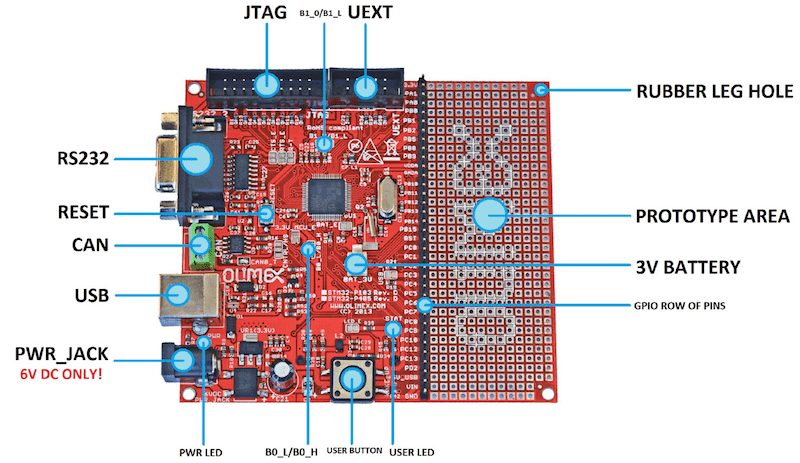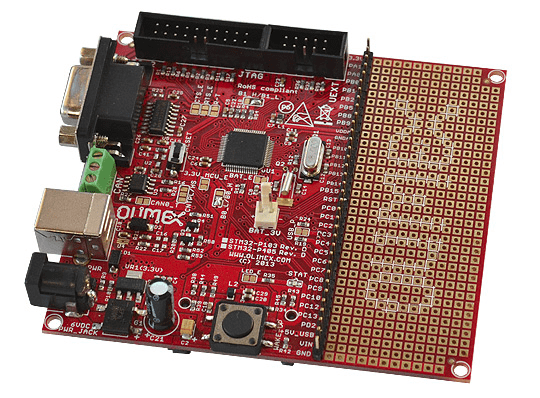OLIMEX-STM32-P405¶
Overview¶
Zephyr applications use the olimex_stm32_p405 board configuration to run on the OLIMEX-STM32-P405 open source hardware. It is based on the STMicroelectronics STM32F405RG ARM Cortex-M4 CPU.
Hardware¶
Information about the board can be found at the OLIMEX-STM32-P405 website and OLIMEX-STM32-P405 user manual. The ST STM32F405RG Datasheet contains the processor’s information and the datasheet.
Supported Features¶
The olimex_stm32_p405 board configuration supports the following hardware features:
| Interface | Controller | Driver/Component |
|---|---|---|
| NVIC | on-chip | nested vectored interrupt controller |
| SYSTICK | on-chip | system clock |
| UART | on-chip | serial port |
| GPIO | on-chip | gpio |
Other hardware features are not supported by the Zephyr kernel.
Pin Mapping¶
LED¶
- USER_LED (red) = PC12
- PWR_LED (red) = power
Push buttons¶
- USER_BUTTON = PA0
- RST = NRST
External Connectors¶
JTAG debug
| PIN # | Signal Name | Pin # | Signal Name |
|---|---|---|---|
| 1 | +3.3V | 11 | |
| 2 | +3.3V | 12 | GND |
| 3 | PB4 / TRST | 13 | PB3 / TDO |
| 4 | GND | 14 | GND |
| 5 | PA15 / TDI | 15 | PB4 / TRST |
| 6 | GND | 16 | GND |
| 7 | PA13 / TMS | 17 | |
| 8 | GND | 18 | GND |
| 9 | PA14 / TCK | 19 | +5V_JTAG |
| 10 | GND | 20 | GND |
UEXT
| PIN # | Wire Name | STM32F405 port |
|---|---|---|
| 1 | +3.3V | |
| 2 | GND | |
| 3 | PA9/USART1_TX | PA9 |
| 4 | PA10/USART1_RX | PA10 |
| 5 | PB6/I2C1_SCL | PB6 |
| 6 | PB7/I2C1_SDA | PB7 |
| 7 | PA6/SPI1_MISO | PA6 |
| 8 | PA7/SPI1_MOSI | PA7 |
| 9 | PA5/SPI1_SCK | PA5 |
| 10 | PA4/SPI1_NSS | PA4 |
GPIO row of pins
| Pin | STM32F405 Pin Functions |
|---|---|
| 3V3 | N/A |
| PA1 | PA1/USART2_RTS/ADC1/TIM2_CH2 |
| PA8 | PA8/USART1_CK/TIM1_CH1/MCO |
| PB0 | PB0/ADC8/TIM3_CH3/TIM1_CH2N |
| PB1 | PB1/ADC9/TIM3_CH4/TIM1_CH3N |
| PB2 | PB2/BOOT1 |
| PB5 | PB5/I2C1_SMBAI/TIM3_CH2/SPI1_MOSI |
| PB8 | PB8/TIM4_CH3/I2C1_SCL/CANRX |
| PB9 | PB9/TIM4_CH4/I2C1_SDA/CANTX |
| VDDA | N/A |
| GNDA | N/A |
| PB10 | PB10/I2C2_SCL/USART3_TX/TIM2_CH3 |
| PB11 | PB11/I2C2_SDA/USART3_RX/TIM2_CH4 |
| PB12 | PB12/SPI2_NSS/I2C2_SMBAL/USART3_CK/TIM1_BKIN |
| PB13 | PB13/SPI2_SCK/USART3_CTS/TIM1_CH1N |
| PB14 | PB14/SPI2_MISO/USART3_RTS/TIM1_CH2N |
| PB15 | PB15/SPI2_MOSI/TIM1_CH3N |
| RST | NRST |
| PC0 | PC0/ADC10 |
| PC1 | PC1/ADC11 |
| PC2 | PC2/ADC12 |
| PC3 | PC3/ADC13 |
| PC4 | PC4/ADC14 |
| PC5 | PC5/ADC15 |
| PC6 | PC6/TIM3_CH1 |
| PC7 | PC7/TIM3_CH2 |
| PC8 | PC8/TIM3_CH3 |
| PC9 | PC9/TIM3_CH4 |
| PC10 | PC10/USART3_TX |
| PC12 | PC12/USART3_CK |
| PC13 | PC13/ANTI_TAMP |
| PD2 | PD2/TIM3_ETR |
| +5V_USB | N/A |
| VIN | N/A |
| GND | N/A |
System Clock¶
OLIMEX-STM32-P405 has two external oscillators. The frequency of the slow clock is 32.768 kHz. The frequency of the main clock is 8 MHz. The processor can setup HSE to drive the master clock, which can be set as high as 168 MHz.
Programming and Debugging¶
The OLIMEX-STM32-P405 board does not include an embedded debug tool interface. You will need to use ST tools or an external JTAG probe. In the following examples a ST-Link V2 USB dongle is used.
Flashing an application to the Olimex-STM32-P405¶
The sample application Hello World is being used in this tutorial.
Connect the ST-Link USB dongle to your host computer and to the JTAG port of the OLIMEX-STM32-P405 board.
Now build and flash the application.
# On Linux/macOS
cd $ZEPHYR_BASE/samples/hello_world
mkdir build && cd build
# On Windows
cd %ZEPHYR_BASE%\samples\hello_world
mkdir build & cd build
# Use cmake to configure a Ninja-based build system:
cmake -GNinja -DBOARD=olimex_stm32_p405 ..
# Now run ninja on the generated build system:
ninja
ninja flash
Run a serial host program to connect with your board:
$ minicom -D /dev/ttyACM0
After resetting the board, you should see the following message:
***** BOOTING ZEPHYR OS v1.8.99 - BUILD: Aug 4 2017 14:54:40 *****
Hello World! arm
Debugging¶
You can debug an application in the usual way. Here is an example for the Hello World application.
# On Linux/macOS
cd $ZEPHYR_BASE/samples/hello_world
# If you already made a build directory (build) and ran cmake, just 'cd build' instead.
mkdir build && cd build
# On Windows
cd %ZEPHYR_BASE%\samples\hello_world
# If you already made a build directory (build) and ran cmake, just 'cd build' instead.
mkdir build & cd build
# If you already made a build directory (build) and ran cmake, just 'cd build' instead.
# Use cmake to configure a Ninja-based build system:
cmake -GNinja -DBOARD=olimex_stm32_p405 ..
# Now run ninja on the generated build system:
ninja debug

